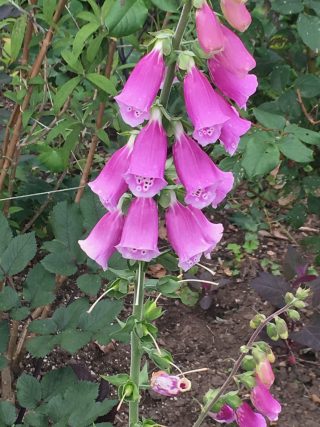The Truth About Foxgloves
Posted in Horticulture on June 11 2018, by Joyce Newman
Joyce H. Newman is an environmental journalist and teacher. She holds a Certificate in Horticulture from The New York Botanical Garden.
 In June, purple foxgloves (Digitalis purpurea) are in bloom at NYBG. Tall, striking spires with dozens of little finger-shaped blooms, foxgloves are native all across western Europe. Traditionally cultivated in English borders, there are about 20 different species. They bloom in colors from yellows, pinks, lavenders, and whites to purple, with dark spots inside the blooms.
In June, purple foxgloves (Digitalis purpurea) are in bloom at NYBG. Tall, striking spires with dozens of little finger-shaped blooms, foxgloves are native all across western Europe. Traditionally cultivated in English borders, there are about 20 different species. They bloom in colors from yellows, pinks, lavenders, and whites to purple, with dark spots inside the blooms.
The leaves form in large clusters during the first year, and there are no blooms. Large and fuzzy green, they look a bit like sage or even spinach. In the second year, the blooms appear and the seeds can eventually be collected for re-planting, or they may naturalize.
Totally Toxic
A folk myth about foxgloves claims that the foxes who make dens in the woodland hills wear the flowers on their paws when they attack rural villagers. Sometimes called “witches’ gloves,” the plant’s toxicity was known for centuries by herbalists. Other common names for the plant are also a dead giveaway to its potent effects, including “witches’ thimbles” and “dead man’s bells”.
The entire plant is poisonous, according to experts. But the leaves, in particular, contain more concentrated toxins.
English botanist William Withering, writing in 1785, was the first to discover the toxic and medicinal qualities of foxgloves. Extracts from the plant contain chemicals called cardiac glycosides—also known as digitalins—used initially for treating some very common heart problems, such as abnormal heart rhythms and symptoms of congestive heart failure, such as swelling of legs.
In the decades to follow, the plant became a significant source of medicine—apothecaries in France reportedly used a painting of the flower as a sort of logo hanging outside their stores to signify their expertise.
In the early 20th century, pharmacologists widely used digitalins for treatment of secondary dropsy (edema) and heart disease. In fact, during World War I in Britain, gardeners would go collecting foxglove leaves in the wild to help the war effort. The leaves were used to extract the medicine.
Meanwhile, for gardeners, one of the most influential garden books at the time, Colour Schemes for the Flower Garden by Gertrude Jekyll, advocated spreading white foxglove seed into the soil to lighten up the edges of dark woodland paths or to screen old tree stumps. Jekyll advises that gardeners forget about the plant for two years until some tall “stately” white spires actually appear.
Luckily, at NYBG we don’t have to wait so long to enjoy the beauty of foxgloves.


Intriguing, informative, and concise! Thank you, Joyce.